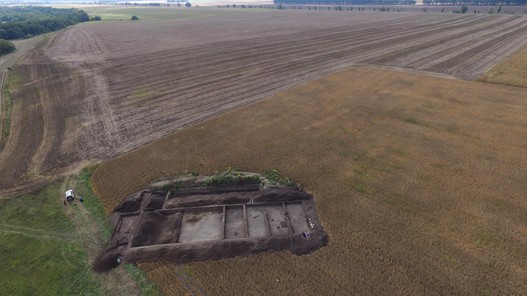Baltic migrants in Kyiv Rus’. Comparative study of the 11th century Ostriv cemetery in Ukraine
The Late Viking Age cemetery of Ostriv was discovered by an Institute of Archaeology of the Natonal Academy of Science of Ukraine (IA NASU) team in 2017, approximately 100 km from Kyiv in the Porossya region. To date, 67 inhumation graves have been excavated in an area of 1400 m2. Most of the artefacts found at Ostriv are uncommon in Ukraine, but are frequently found in the East Baltic region. The preliminary results describe the Ostriv population as East Baltic immigrants, who served as mercenaries at the Rus’ river frontier during the reign of Yaroslav the Wise, in the first third-half of the 11th century AD.
To identify the most probable cultural and geographical origin of the Ostriv paleo-population, the logistics of migration and demographic features, in 2019 ZBSA and IA NASU, together with CAU laboratories, started a joint pilot study “Baltic migrants in Kyiv Rus’. Comparative study of the 11th century Ostriv cemetery in Ukraine”, using a wide range of natural scientific methods: 1. High precision radiocarbon dating (AMS 14C), 2. Dietary stable isotope research, 3. Archaeogenetic (ancient DNA) analysis of human genomes; 4. Non-destructive metal artefact analysis (Transmission Electron Microscopy (TEM), Focused Ion Beam (FIB). Research at Ostriv is based on three general topics: frontiers, transport, and demography, concentrating on chronological, dietary and genetic research.

The radiocarbon dating of Ostriv skeletal remains gave a systematic sequence of calibrated dates, divided into 2 phases: 1 – about 980-1020 cal AD; 2 – 1010-1040 cal AD (the majority of dates). Phase 1 could correspond to the first wave of migrants during the reign of Volodymyr the Great (ruling from 978/980 to 1015). Phase 2 is associated with the brief rivalry of Svyatopolk and Yaroslav the Wise, and the long reign of the latter (ruling from 1019 to 1054 AD). Nitrogen and carbon (δ15N and δ13C) stable isotopes, reflecting the type of diet, proves the close similarity of Ostriv and East Baltic populations.
The first aDNA analyses of Ostriv samples gave good results, with genetic gender determination. Using the f3 statistics of direct genetic relationships between populations, the samples show the greatest agreement with modern individuals from Lithuania and Estonia, and then Iceland. Thus, the first results of the genetic analysis demonstrate the possible external origin of the Ostriv individuals, placing them closer to the Baltics and Scandinavia. This corresponds to the preliminary results of anthropological study of the Ostriv skeletal remains.
Ostriv is a bright example of a late Viking Age site, demonstrating the opportunities for multi-disciplinary international research on a complex multi-ethnic population. From the very beginning, the Ostriv pilot study was considered as a basis for further German-Ukrainian cooperation.
The integration of Eastern Europe into Central and Northern European networks around the year 1000 AD was a dynamic process, best reflected through archaeological features. Modern archaeological approaches can come to results at an appropriate scientific level. It is therefore the strategy of ZBSA, together with Ukrainian and other German partners, to undertake several case studies of archaeological sites in Ukraine for a comprehensive synthesis, to develop regional models of historical development as a starting point for broader analyses and interpretations. Studying new and extant archaeological data together with a wide range of natural scientific methods, such as high-precision radiocarbon dating, analysis of dietary stable isotopes and archaeogenetics, we have the opportunity to understand these complex processes in a European perspective and within a network of excellent research institutions. The „Ostriv“ pilot study is developing towards a long-term ZBSA and IA NASU scientific project.
Themenbereiche
Mensch und Gesellschaft
Forschungsschwerpunkte
–
Mitarbeiter
Dr. Roman Shiroukhov, Prof. Dr. D.r h.c. Claus von Carnap-Bornheim
In Kooperation mit
Natonal Academy of Science of Ukraine (IA NASU)